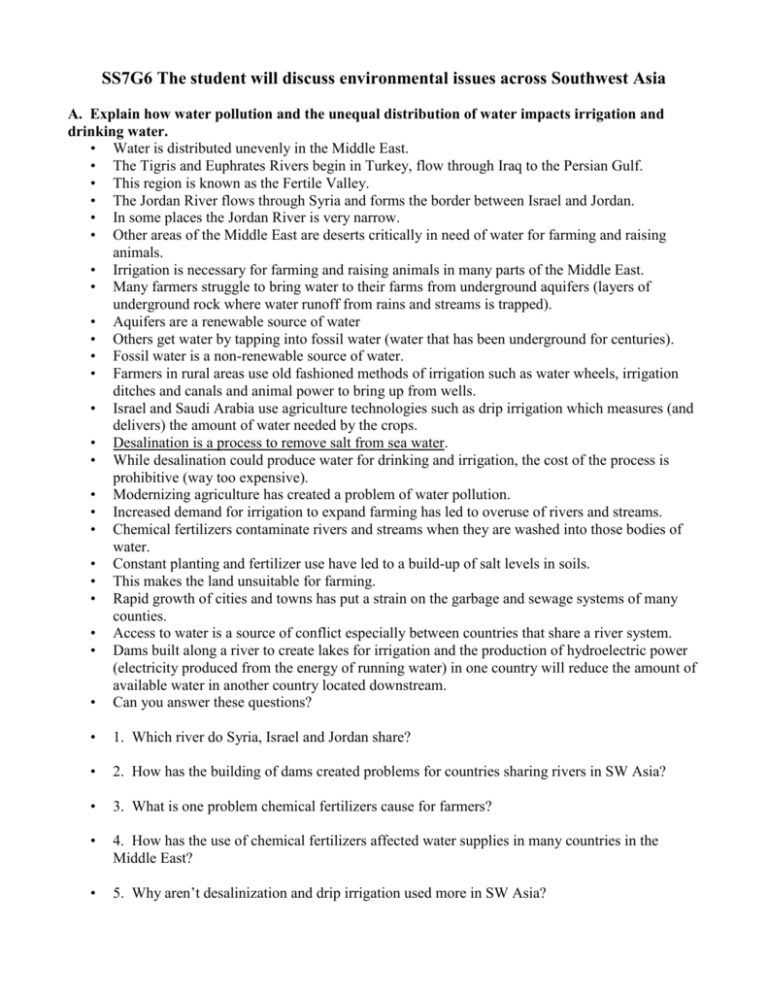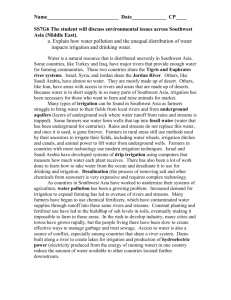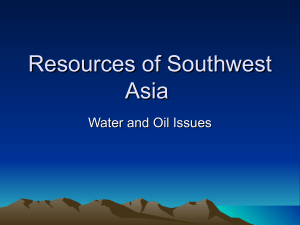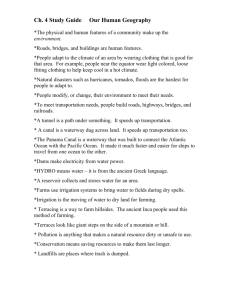SS7G6 The student will discuss environmental issues across
advertisement

SS7G6 The student will discuss environmental issues across Southwest Asia A. Explain how water pollution and the unequal distribution of water impacts irrigation and drinking water. • Water is distributed unevenly in the Middle East. • The Tigris and Euphrates Rivers begin in Turkey, flow through Iraq to the Persian Gulf. • This region is known as the Fertile Valley. • The Jordan River flows through Syria and forms the border between Israel and Jordan. • In some places the Jordan River is very narrow. • Other areas of the Middle East are deserts critically in need of water for farming and raising animals. • Irrigation is necessary for farming and raising animals in many parts of the Middle East. • Many farmers struggle to bring water to their farms from underground aquifers (layers of underground rock where water runoff from rains and streams is trapped). • Aquifers are a renewable source of water • Others get water by tapping into fossil water (water that has been underground for centuries). • Fossil water is a non-renewable source of water. • Farmers in rural areas use old fashioned methods of irrigation such as water wheels, irrigation ditches and canals and animal power to bring up from wells. • Israel and Saudi Arabia use agriculture technologies such as drip irrigation which measures (and delivers) the amount of water needed by the crops. • Desalination is a process to remove salt from sea water. • While desalination could produce water for drinking and irrigation, the cost of the process is prohibitive (way too expensive). • Modernizing agriculture has created a problem of water pollution. • Increased demand for irrigation to expand farming has led to overuse of rivers and streams. • Chemical fertilizers contaminate rivers and streams when they are washed into those bodies of water. • Constant planting and fertilizer use have led to a build-up of salt levels in soils. • This makes the land unsuitable for farming. • Rapid growth of cities and towns has put a strain on the garbage and sewage systems of many counties. • Access to water is a source of conflict especially between countries that share a river system. • Dams built along a river to create lakes for irrigation and the production of hydroelectric power (electricity produced from the energy of running water) in one country will reduce the amount of available water in another country located downstream. • Can you answer these questions? • 1. Which river do Syria, Israel and Jordan share? • 2. How has the building of dams created problems for countries sharing rivers in SW Asia? • 3. What is one problem chemical fertilizers cause for farmers? • 4. How has the use of chemical fertilizers affected water supplies in many countries in the Middle East? • 5. Why aren’t desalinization and drip irrigation used more in SW Asia?











